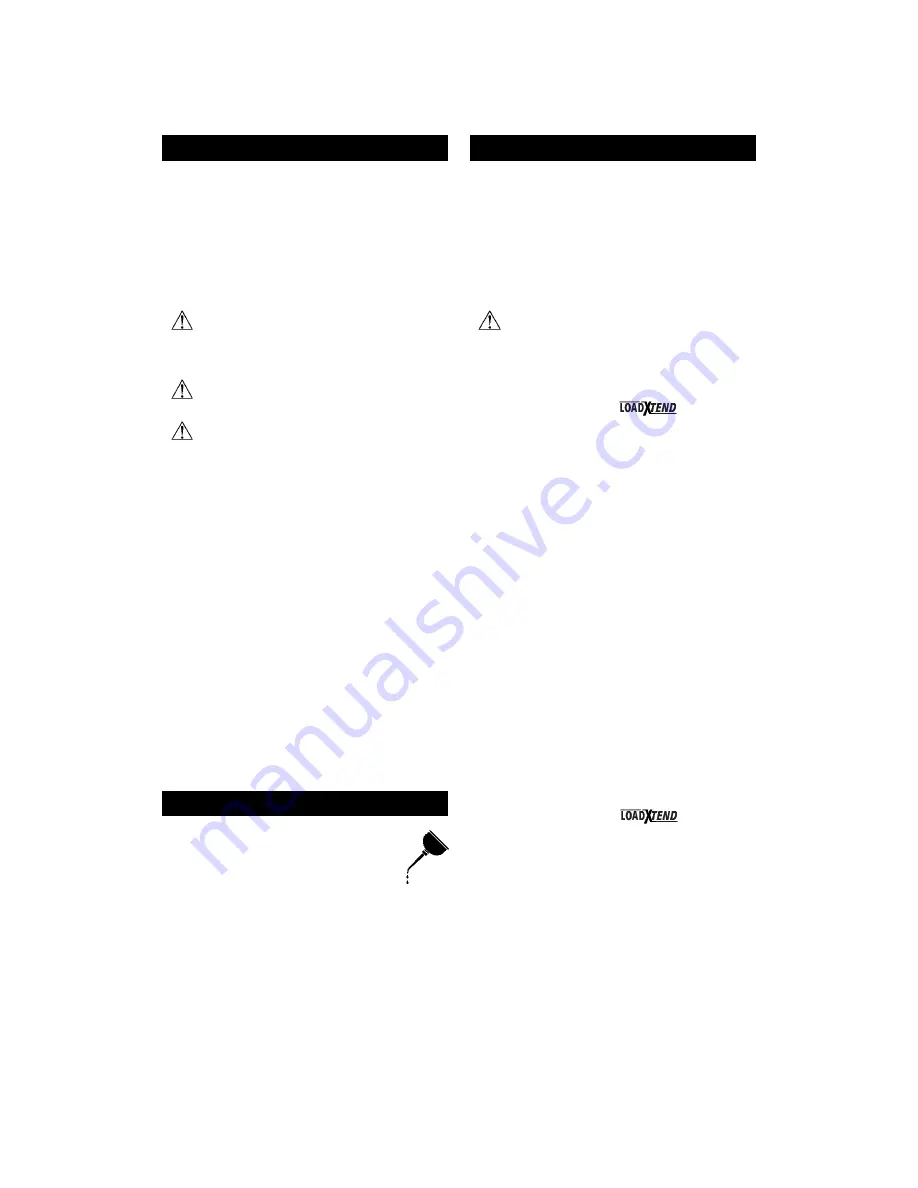
CONNECTION & AIR SUPPLY
This tool requires clean & dry air. The use of a filter and
a pressure regulator is recommended.
Use a detachable male coupler with 3/8" NPT male
treads. The use of a 3/8" (1 cm) diameter air supply hose
is recommended. A smaller hose or a hose longer than
50' (15 m) could cause a pressure drop when the tool is
activated repeatedly.
Always use a free-flow connection for the
compressed air supply to prevent that the tool
stays charged after disconnecting the air
supply hose.
Unload tool before connecting air to prevent
accidental discharge.
To prevent injury or accidental damage to the
finished surface of the installed floor, rest the
tool onto the subflooring when connecting air,
moving tool to a different work area, loading the
tool or performing any maintenance to the tool.
Dirt, dust, and other particles in the air supply can cause
sluggish operation or premature wear. Drain water from
the compressor tank regularly. The compressor start-stop
limits should be set to deliver an air pressure of at least
100 psi (7 bar) at all times. Consult the compressor
manual or dealer for instructions on how to make this
adjustment.
At 80 psi (5.5 bar) and 40 hits per minute, this tool
consumes approximately 1.9 cu.ft (50
) of air per minute
at 70
F (21
C). Higher air pressure will increase the
consumption of compressed air.
This tool is designed to be operated with a compressed
air pressure of 80 to 100 psi (5.5-7.0 bar). Air pressure of
90 psi (6.2 bar) is adequate for most situations, although
occasionally, a higher pressure could be necessary.
Never not use a compressed air pressure higher than
110 psi (7.6 bar).
PREVENTIVE MAINTENANCE
This tool requires minimal lubrication. Use only
detergent-free oil such as Primatech P-090.
Few drops of oil weekly in the air inlet is
sufficient. Other types of lubricant may degrade
the seals.
Check periodically to make sure that the head assembly
is fully screwed onto the main body. A loosen head will
damage the threads.
LOADING THE TOOL
This tool comes in one of 3 different configurations:
• L-type 16
GA
nails in lengths of 1½" (38 mm), 1¾"
(45 mm) or 2" (50 mm)
• T-type 16
GA
nails in lengths of 1½" (38 mm) or 2" (50
mm)
• ½" crown 15½
GA
staples in lengths of 1½" (38 mm),
1¾" (45 mm) or 2" (50 mm)
Use only the type of fasteners identified on the
magazine. The use of any other type of
fasteners will damage the tool.
P250AL – Loading the tool with L-type 16
GA
nails:
This tool is fitted with the
technology. Its
automatic magazine holds & feeds 200 nails (2 strips)
in an assembly no longer than a conventional one. Its
exclusive pusher locks into a pre-armed position,
allowing nails to be fed by gravity until it automatically
engages behind. To load the tool:
• Insert one or two rows of flooring nails into the back
end of the magazine.
• Pull the pusher back completely and release it until it
locks in position or engages behind the nails.
• To remove nails from the magazine, simply squeeze
the pusher with your thumb and index finger and allow
it to recoil slowly. You can then slide out remaining
nails.
P250AT – Loading the tool with T-type nails:
• Insert a row of T-type nails into the back end of the
magazine.
• Pull back on the pusher until it engages behind the
nails.
• To remove nails from the magazine, simply squeeze
the pusher with your thumb and index finger and allow
it to recoil slowly. You can then slide out remaining
nails.
P250AS – Loading the tool with flooring staples:
This tools is fitted with the
technology. Its
automatic magazine hold & feed 4 strips of flooring
staples in an assembly no longer than a conventional
one. Its exclusive pusher locks into a pre-armed
position, allowing staples to be fed by gravity until it
automatically engages behind. To load the tool:
• Insert up to 4 strips of flooring staples into the back of
the magazine.
• Pull the pusher back completely and release it until it
locks in position or engages behind the last strip.
• To remove staples from the magazine, pull back
completely and hold the pusher, tilt the tool to slide
back remaining staples.

























